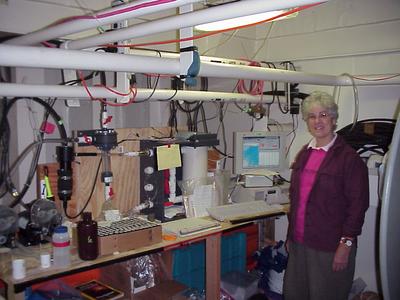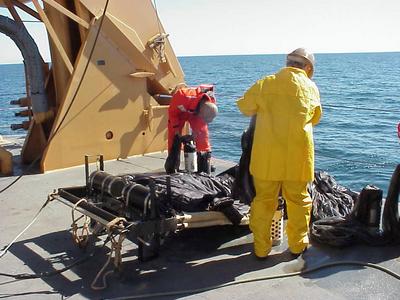12 August, 2002
We're still at the 3000 meter station, and we'll be here through this
afternoon. It seems like a long time to spend at one station, but it's
critical that the scientists gather the information they need at all depths.
Remember that this project is Shelf-Basin Interactions. It's just as
important to sample here in the basin as it is to sample at the shelf and
the slope stations.
If you get a chance to re-read the journal from July 28 about Carin,
Stephane and Bob's work on copepod grazing and egg production (copepods are
the mesozooplankton) and the journal from August 8 about Ev and Jennifer's
work with the microzooplankton it will help you to fit today's journal into
the big picture. Sharon Smith's work is also related to the
mesozooplankton. Sharon is a professor of marine science and the Chair of
the Division of Marine Biology and Fisheries at the University of Miami.
Peter Lane, a research associate at the University of Miami has been working
with Sharon since 1979. Leopoldo Llinas is also working with Sharon; he is
a graduate student in oceanography at the University of Miami.
I spoke with Sharon in what she jokingly refers to as her "dungeon." It's a
tiny room below the science lab and through the winch wire room, and it's
officially the aft fueling hose room. In addition to Sharon's equipment,
the room is home to the large orange tubes which would only be used if there
were an oil spill. It's also where you find the XBT, the expendable
bathythermograph. Bathy refers to depth and thermo refers to temperature so
you can tell what this measures. Sharon's equipment actually measures
temperature, salinity, chlorophyll and turbidity (how much light gets
transmitted through the water) in the surface water which continually flows
through it. The chlorophyll measurement actually comes through as a voltage
reading. By extracting the chlorophyll from water samples and getting
measurements, they can use these numbers to calculate chlorophyll from the
voltage readings.
Since there is a constant flow of water through their system, Sharon, Peter
and Leopoldo can measure out an exact amount. They then filter it to
collect the zooplankton. That way they know exactly how much zooplankton
they have in a specific amount of water. They will filter, on average,
about 60 liters in a ten minutes period. They will do this at different
depths to try to understand the distribution (how many there are) of the
copepods. (For a picture of a copepod, greatly magnified, see the journal
photos of July 28). They will also relate this to the ship's data log. Sean
Kuhn and Steve Roberts have set up the computer so she gets a triple screen.
One displays the chlorophyll readings, another shows the ship's position,
and the third is a real time data display including all the information from
the sensors, latitude, longitude, wind speed, depth, etc.
What exactly are Sharon, Peter and Leopoldo looking for? As I have
mentioned before, the shelf is the area off the coast that gradually gets
deeper as it moves to the slope and into the basin. The shelf of the
Chukchi Sea has the Bering Sea on one side and the deep Arctic Ocean on the
other side. Therefore, the large copepods that are found on the Chukchi Sea
shelf have either come from the Bering Sea or the Arctic Ocean. These large
copepods can't complete their life cycle on the shelf. They need to be in
the deep basin during the fall and winter where they seem to hibernate.
During that time, they have almost no measurable respiration, and their
metabolism (all their body's chemical processes) slows way down as they live
off the large amount of stored fat that they build up in their bodies during
the spring and the summer.
The large copepods are the key piece of the food chain for all the filter
feeding mammals (i.e. the baleen whales) and for many birds and fish. If
there is less ice and the circulation patterns of the water change, the
copepods won't get moved up onto the shelf by the currents and the entire
food chain might shift. That's the reason that Sharon, Peter and Leopoldo
are trying to find out the distribution of the copepods. They want to know
how many are in the deep water (3000 meters) which is the source of the
copepods, how many are on the shelf, and whether the populations mix. While
Carin, Bob and Stephane are looking at egg production, Sharon's group is
actually looking at the baby copepods (nauplius). They will also do genetic
sequencing (DNA analysis) of the adults in order to identify the species
since all the nauplii tend to look alike. This will help them to know which
species are in which areas.
To gather their samples, Sharon's group uses the previously described system
in the "dungeon" in addition to Bongo nets and the MOCNESS tow. The Bongo
nets are two extremely large nets which are dropped vertically into the
water and then brought to the surface. The water passes through, but the
zooplankton (and sometimes other organisms such as jellyfish) get trapped in
the net. MOCNESS stands for Multiple Opening and Closing Nets and
Environmental Sensing System. It's a wonderful piece of equipment designed
to filter the water at different depths all in one tow. Usually it is towed
behind the ship for four to five hours but, unfortunately, it has not worked
since it ran into a considerable amount of ice during one of the tows.
Once again, it is important to look at all the research being done on board
the ship. The two mesozooplankton studies obviously tie in with the
microzooplankton study. But, if you think about the importance of the
chemical and physical factors of the water, you can begin to see how it all
fits together. Even though each of these studies is important individually,
each research team utilizes the information from other teams to understand
their own data more completely.

<> Sharon Smith's work on this cruise involves sampling copepod populations on the shelf, the slope and in the deep basin. She's seen here in her small lab in the stern of the ship.

<> MOCNESS stands for Multiple Opening and Closing Nets and Environmental Sensing System. It is used to filter water for zooplankton at different depths all in one tow behind the ship.

<> The Bongo nets are two extremely large nets which are dropped vertically into the water and then brought to the surface. The water passes through, but the zooplankton get trapped in the net.

<> Leopoldo Llinas, first on the left in this picture, is a graduate student at the University of Miami. Peter Lane, in the middle, is a research associate at the University of Miami. He has worked with Sharon since 1979. They are all standing next to the area where they do some of their work.
Contact the TEA in the field at
.
If you cannot connect through your browser, copy the
TEA's e-mail address in the "To:" line of
your favorite e-mail package.
|
